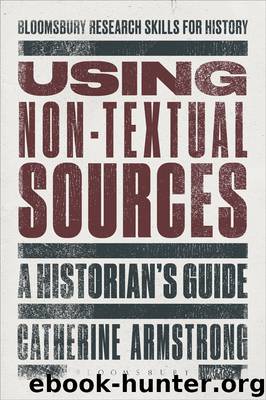Using Non-Textual Sources by Catherine Armstrong

Author:Catherine Armstrong
Language: eng
Format: epub
Publisher: Bloomsbury
* * *
Movies are an excellent resource for those wanting to research the nineteenth-century American West. Throughout the second half of the twentieth century, Hollywood’s most famous directors and actors were employed in making Westerns, a film genre that sought to depict a romantic version of the history of the conquest of the American West. It pitted white cowboys against savage Native Americans while simultaneously writing out of the story other minority groups such as the Chinese, African-Americans and even women. As such, these films are flawed in their depiction of the past and they reflect the values of a conservative and conflicted twentieth-century United States as much as telling the story of westward expansion.
The Searchers is one of the iconic movies of this genre. Made by director John Ford, whose name is synonymous with Westerns, and starring John Wayne, the actor most associated with the genre, the film represents both change and continuity when we consider the trajectory of the depiction of Native Americans in Westerns. It was considered enlightened for its time in its depiction of mixed-race natives, permitting them to become key characters and giving them agency and voices within the story. On the other hand, the character of Ethan, played by Wayne, is racist and cannot bear the thought of his sister, who has been kidnapped by the Comanches, having lived with them for five years. He would rather see her dead than the wife of a native. Ford intended the character of Ethan to be viewed critically by the audience, so that they might reject his ignorance towards the natives, but in casting John Wayne in this role, Ford made a hero of the character. Wayne had played the uncomplicated US hero in so many of his previous films that audiences assumed that he was doing so again here. Also Ford used the Comanches in the film to convey his message; he does not think about their portrayal, their history and their agency, in and of itself. However, liberal Ford reacted to the events of his time and allegorically depicted the fear of miscegenation arising from the Brown versus the Board of Education Supreme Court decision of the same year, which in effect desegregated US universities and schools.
Historically, the film does not purport to depict a real event, although similarities can be drawn with the kidnap in 1836 of Cynthia Ann Parker by the Comanche tribe when she was a child. She lived with the Comanches for twenty-four years and bore Peta Noconah, her Indian husband, three children, including a future chief, Quanah. She was taken against her will by the Texas Rangers aged 34 and never properly settled back into white US society. One of the film’s main themes is racial mixing and the fear of it. Mixed race relationships between natives and whites had existed since the first contact period and society’s concern about them fluctuated over time. It was often possible for the offspring of such relationships, such as Quanah Parker, to excel because they were able to move easily across both worlds.
Download
This site does not store any files on its server. We only index and link to content provided by other sites. Please contact the content providers to delete copyright contents if any and email us, we'll remove relevant links or contents immediately.
| Anthropology | Archaeology |
| Philosophy | Politics & Government |
| Social Sciences | Sociology |
| Women's Studies |
Cecilia; Or, Memoirs of an Heiress — Volume 1 by Fanny Burney(32060)
Cecilia; Or, Memoirs of an Heiress — Volume 3 by Fanny Burney(31455)
Cecilia; Or, Memoirs of an Heiress — Volume 2 by Fanny Burney(31406)
The Great Music City by Andrea Baker(30780)
We're Going to Need More Wine by Gabrielle Union(18631)
All the Missing Girls by Megan Miranda(14725)
Pimp by Iceberg Slim(13777)
Bombshells: Glamour Girls of a Lifetime by Sullivan Steve(13683)
Fifty Shades Freed by E L James(12910)
Talking to Strangers by Malcolm Gladwell(12869)
Norse Mythology by Gaiman Neil(12825)
For the Love of Europe by Rick Steves(11455)
Crazy Rich Asians by Kevin Kwan(8886)
Mindhunter: Inside the FBI's Elite Serial Crime Unit by John E. Douglas & Mark Olshaker(8699)
The Lost Art of Listening by Michael P. Nichols(7159)
Enlightenment Now: The Case for Reason, Science, Humanism, and Progress by Steven Pinker(6871)
The Four Agreements by Don Miguel Ruiz(6314)
Bad Blood by John Carreyrou(6274)
Weapons of Math Destruction by Cathy O'Neil(5829)
